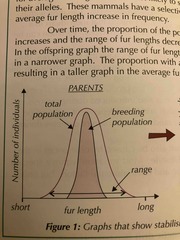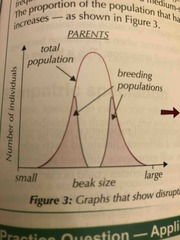![]()
![]()
![]()
Use LEFT and RIGHT arrow keys to navigate between flashcards;
Use UP and DOWN arrow keys to flip the card;
H to show hint;
A reads text to speech;
34 Cards in this Set
- Front
- Back
|
Define - variation? |
The differences that exist between individuals |
|
|
Define - intraspecific variation? |
Individuals in a population show a wide range of different phenotypes |
|
|
What is variation within a species caused by? |
Genetic (e.g. crossing over) and/or environmental factors (Differences in the environment like food, climate, or lifestyle (e.g. some girls are bigger than others)) |
|
|
Why does genetic variation exist within a species? |
• Individuals of the same species have the same genes But • They have different alleles |
|
|
How does genetic variation within a species happen? |
• random mutations - produces new alleles • crossing over (in meiosis) • independent segregation of homologous chromosomes • random fertilisation of gametes (during sexual reproduction) |
|
|
Most variation within a species is caused by a combination of genetic and environmental factors e.g. Weight - some people can be genetically disposed - but if you eat loads you will be fat |
- |
|
|
Only genetic variation results in evolution. (Not environmental variation) |
- |
|
|
Define - Evolution? |
The change in the heritable characteristics of biological populations over successive generations |
|
|
The frequency of an allele in a population changes over time |
. |
|
|
Define - selection pressures? |
Pressures that affect an organism’s chances of survival e.g. predation, disease, competition |
|
|
How do selection pressures cause natural selection? |
• Create a struggle for survival • There is variation between individuals, meaning some are better adapted to the selection pressure than others (have phenotypes that increase their chance of survival) • Produces differential levels of survival and reproductive success in a population - some alleles (beneficial alleles) are more likely to be passed on • frequency of beneficial alleles increase in the gene pool |
|
|
How do selection pressures cause natural selection? |
• Create a struggle for survival • There is variation between individuals, meaning some are better adapted to the selection pressure than others (have phenotypes that increase their chance of survival) • Produces differential levels of survival and reproductive success in a population - some alleles (beneficial alleles) are more likely to be passed on • frequency of beneficial alleles increase in the gene pool |
|
|
What are the different types of natural selection? |
• Stabilising selection • Directional selection • Disruptive selection |
|
|
The effect of natural selection on allele frequencies depends on the selection pressures acting on the population! |
- |
|
|
Define - stabilising selection? |
Individuals with alleles for characteristics is towards the middle of the range are more likely to survive and reproduce |
|
|
When does stabilising selection occur? |
When the environment isn’t changing |
|
|
What is the effect of stabilising selection on allele frequencies in a population? |
• Reduces the range of possible phenotypes (alleles) |
|
|
Stabilising selection example Mammal population/fur length |
• In the population there’s a range of fur length • In a stable climate, having fair at the extremes of this range (very short/very long) reduces the chances of surviving as it’s harder to maintain the right body temperature - these mammals have a selective disadvantage • Mammals with average fur length are most likely to survive reproduce and pass on the alleles - selective advantage • Average fur length alleles increase in frequency • Over time, the proportion of the population with average fur length increases, and the range of fur lengths decreases |
|
|
Stabilising selection example Mammal population/fur length |
• In the population there’s a range of fur length • In a stable climate, having fair at the extremes of this range (very short/very long) reduces the chances of surviving as it’s harder to maintain the right body temperature - these mammals have a selective disadvantage • Mammals with average fur length are most likely to survive reproduce and pass on the alleles - selective advantage • Average fur length alleles increase in frequency • Over time, the proportion of the population with average fur length increases, and the range of fur lengths decreases |
|

Draw the graph for the offspring (after stabilising selection has occurred)? |

Back (Definition) |
|
|
What is meant by an organism’s ‘fitness’ ? |
How well-adapted an organism is to survive and reproduce successfully in its environment |
|
|
Define - breeding population? |
The organisms that are surviving, reproducing and passing on their alleles |
|
|
Define - directional selection? |
Individuals with alleles for a single extreme phenotype are more likely to survive and reproduce |
|
|
When can directional selection occur? |
In response to an environmental change |
|
|
What is the effect of directional selection on allele frequencies in a population? |
The mean moves towards one extreme (directional movement of the mean) But Range of phenotypes stays about the same |
|
|
Example of directional selection Cheetahs/speed |
• It’s likely that Cheetahs developed the characteristic of being very fast through directional selection • Individuals that have alleles for increased speed are more likely to catch prey - so more likely to survive, reproduce and pass on their alleles • Over time, the frequency of alleles for high speed increases, the population becomes faster (mean speed increases), as the slower individuals are outcompeted |
|

Draw the graph of the offspring (after directional selection has occurred)? |

Back (Definition) |
|
|
Define - disruptive selection? |
Individuals with alleles for extreme phenotypes are more likely to survive and reproduce (Both extremes favoured, not just one) |
|
|
When does disruptive selection occur? |
Environmental change taking place, in which the environment favours more than one phenotype |
|
|
Disruptive selection example Birds/beak size |
• In bird populations there’s a range of beak sizes • Birds with large beaks are specialised to eat large seeds • Birds with small beaks are specialised to eat small seeds • In an environment where the majority of seeds are large or small and very few are medium-sized - birds with medium-sized beaks may have a reduced chance of survival (selective disadvantage) • But with large or small beaks are more likely to survive, reproduce and pass on their alleles • You get 2 discrete breeding populations, one with small birds, one with large birds • Over time, the alleles for a large beak and a small beak increase in frequency, but the alleles for a medium-sized beak decrease in frequency (Eventually phenotypes towards the middle of the range are lost - opposite of stabilising selection) |
|
|
Disruptive selection example Birds/beak size |
• In bird populations there’s a range of beak sizes • Birds with large beaks are specialised to eat large seeds • Birds with small beaks are specialised to eat small seeds • In an environment where the majority of seeds are large or small and very few are medium-sized - birds with medium-sized beaks may have a reduced chance of survival (selective disadvantage) • But with large or small beaks are more likely to survive, reproduce and pass on their alleles • You get 2 discrete breeding populations, one with small birds, one with large birds • Over time, the alleles for a large beak and a small beak increase in frequency, but the alleles for a medium-sized beak decrease in frequency (Eventually phenotypes towards the middle of the range are lost - opposite of stabilising selection) |
|
|
Explain why in the bird example you end up with 2 separate breeding populations? |
• The mating is assortative (non-random) • Birds with small beaks are more likely to mate with other birds with small beaks and they are with large-beaked birds |
|

Draw the graph for the offspring (after disruptive selection has occurred)? |

Back (Definition) |
|
|
What effect does disruptive selection have on allele frequencies in a population? |
Causes phenotypes at the extreme ends of a range to increase in frequency Phenotypes in the middle of the range decrease in frequency (eventually lost) |

